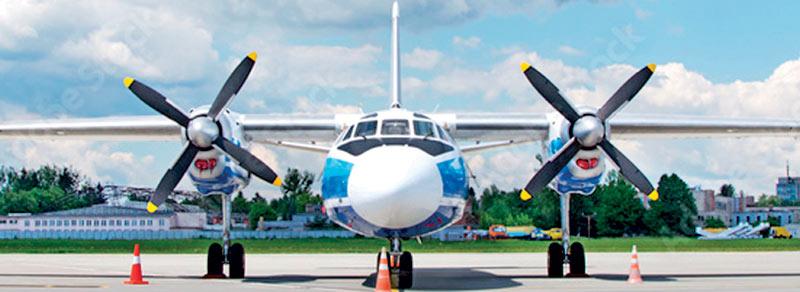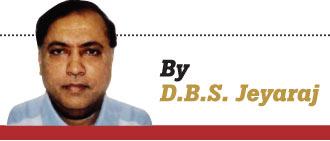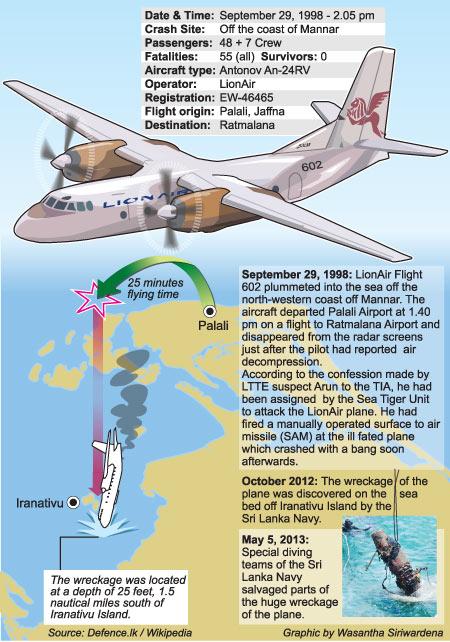30 Dec 2023 - {{hitsCtrl.values.hits}}

The focus of this two-part article is the tragic plight of Lionair 602 flight twenty-five years ago. The first part of this article published last week related how the Liberation Tigers of Tamil Eelam (LTTE) shot down an Antonov 24 carrying 48 passengers and 7 crew on 29 September 1998. This second and final part will describe the prevailing circumstances before and after the downing of Flight 602 in the seas off the Mannar coast by the LTTE known widely as the ‘tigers’. The tragic incident of 1998 occurred during the long war between the Sri Lankan armed forces and the LTTE which ended in May 2009.
 As stated earlier, the Sri Lankan Army had re-captured Jaffna through “Operation Riviresa” in 1995-96. Earlier, the LTTE had been in control of the area. Even though the Jaffna peninsula was controlled by the state, Jaffna remained inaccessible by land from the rest of the country as the LTTE continued to control a major portion of the northern mainland, known as the Wanni. Transport to and from the Jaffna peninsula was possible only by air or sea.
As stated earlier, the Sri Lankan Army had re-captured Jaffna through “Operation Riviresa” in 1995-96. Earlier, the LTTE had been in control of the area. Even though the Jaffna peninsula was controlled by the state, Jaffna remained inaccessible by land from the rest of the country as the LTTE continued to control a major portion of the northern mainland, known as the Wanni. Transport to and from the Jaffna peninsula was possible only by air or sea.
Civilians were earlier flown to and from Jaffna in Air Force flights, for a fee. From August 1996, civilian air transport was handed over to Lion Airlines, a private airline. The airline, which enjoyed a monopoly in this area, immediately increased the fare to almost double the earlier rate. Operating flights from Colombo to Jaffna and back was highly lucrative. The demand for transport to Jaffna was tremendous and there was always a long waiting list. Subsequently, a second private airline, “Monara”, was allowed to operate flights to Jaffna.
The LTTE was then in possession of anti-aircraft missiles. The tigers had from 1996 onwards brought down a few Sri Lankan Air Force planes and helicopters by firing surface to air, SAM-7 missiles. As such, SLAF aircraft usually flew far out to the sea from Palaly and proceeded towards Colombo.
When civilian flights between Jaffna and Colombo commenced, the planes were asked to observe the same safe routes in the interests of civilian passenger safety. This rule however was frequently observed in the breach by the airlines concerned.
 In a bid to cut down on fuel costs and reduce flying time, the passenger planes regularly deviated from the safe route and flew by the shorter route hugging the northern coast. According to the University Teachers for Human Rights (Jaffna) report, this was known to Flight Control at Palaly and the Defence Ministry had been directly told about it. But no effective action was taken.
In a bid to cut down on fuel costs and reduce flying time, the passenger planes regularly deviated from the safe route and flew by the shorter route hugging the northern coast. According to the University Teachers for Human Rights (Jaffna) report, this was known to Flight Control at Palaly and the Defence Ministry had been directly told about it. But no effective action was taken.
As stated earlier, the Sri Lankan Government began adopting in 1997 the controversial practice of mingling service personnel with civilian passengers aboard Lionair and Monara flights. Sometimes the planes were chartered exclusively to transport troops and there were instances of passengers being offloaded at the last minute. This practice of mixing security personnel with civilian passengers was certainly a violation of the international humanitarian law, in spirit though not in letter.
LTTE Warnings
After awhile, the LTTE began warning the Airlines concerned not to carry security personnel on board or charter civilian planes to the armed forces. These warnings went unheeded. Thereafter, the LTTE began to issue dire threats. Again they were ignored. Although the LTTE had relocated en masse to the Wanni after “Operation Riviresa”, it continued to maintain a clandestine presence in the peninsula with a local “headquarters” in Pungudutheevu.
According to the UTHR (J), the LTTE’s warning to the airlines not to charter aircraft to the security forces had largely been downplayed and suppressed by the Government and the airlines. The public was not apprised of the seriousness of the situation. No measures were reportedly taken to enforce adherence to secure routes.
It is against this backdrop that the September 29 tragedy occurred. Here is a brief description of the events that preceded the attack on the Lionair plane.
The LTTE sent letters dated August 9, 1998, to both Lion and Monara that they should stop allowing their planes being used to ferry security personnel to and from Jaffna. These were disregarded. The subject heading of the letters was “Notice of Attack”.
Then on September 13th 1998, a second letter on the letterhead of the Thamil Eelam Administrative Service, signed by Thooyavan, the Jaffna district leader of the LTTE, was delivered. The letter read as follows:
“We have already sent you a letter regarding the conduct of the airlines. You have not taken any action so far. On the contrary, you have continued to cooperate with the armed forces. Therefore, as soon as you see this letter, please contact your management and ask them to temporarily halt the services until further notice. If instead you continue the air service and an aircraft is attacked resulting in danger to the Tamil people you must take full responsibility and would also have to take the due punishment administered by ourselves. Any aircraft flying after September 15 would be subject to our attack. While informing you of this with a heavy heart we are also informing the people through leaflets”
On 17 September 1998, Monara suspended its Jaffna flights. The EPRLF issued a statement on the following day (September 18) criticising the LTTE for this disruption.
On September 23, the Lion Airlines manager in Jaffna received a letter from the LTTE, which asked him to quit the post. He promptly did so.
Letter to “Uthayan”
On September 24, another letter from the LTTE, signed by the chief of its political wing, Manimaran, was delivered to the Tamil daily published in Jaffna, Uthayan. Titled “A request to the people”, it was a warning and an appeal to the people to stop flying.
Although the LTTE wanted it to be published prominently, the prevailing media censorship in force then prevented the paper from doing so. Had the paper been allowed to do so by the authorities a very large number of civilians in Jaffna would have been made aware of the perilous situation. They may have been wary or cautious about flying to and from Jaffna.
Later on, handwritten posters, asking people to avoid air travel, appeared at several public places, with the caption, “A warning to the common people.’’ Letters warning against air travel were sent also to the Jaffna University, the Traders Association and some schools.
Another leaflet in Tamil under the heading “A request to the people of the Jaffna peninsula who are subject to military oppression,” issued by the LTTE’s political wing, was circulated in Jaffna. A paragraph of it stated as follows:
“In the guise of opening a road to Jaffna for the people, or of providing transportation for them, the Army is doing things to maximise its own interests. Under the pretext of running an air service for the people of the peninsula it is not only squeezing a great deal of money out of them but is using these services to fulfil its military aims.... for this reason, banning air travel and taking action against those defying this ban have become unavoidable. Therefore we inform those who travel by air that it would be safer for them in coming times to avoid air travel and to travel by sea.”
LTTE Responsible
In the context of these threats and warnings by the LTTE being publicised, it became crystal clear to many Jaffna Tamils who were aware of the LTTE’s warnings that it was the LTTE that was responsible for the shooting down of the plane. If the censorship had not circumscribed the Tamil newspaper Uthayan, more people would have known of the LTTE’s warning and perhaps avoided air travel.
Callous Disregard
Furthermore, it was apparent that Lion Airlines itself had shown a callous disregard and lack of concern for the safety of both the passengers and the crew. The airline had not bothered to warn the public of these developments despite the serious nature of the LTTE’s threats.
Lack of Concern
The then Government too displayed a serious lack of concern for the people. It further hurt Tamil sentiments by not expressing one word of sympathy for the victims of the tragedy. There was also a visible lack of cooperation with the people in their efforts to recover the bodies of the passengers. The attitudes of both the state and the airline deserved condemnation.
Horrendous Crime
This criticism of the Government and the Airline does not absolve the LTTE of the blame and responsibility for this horrendous tragedy. That it did warn the airlines concerned is evident but this fact cannot help condone the heinous nature of its crime against humanity, that too of a section with which it claims ethnic kinship.
With the wisdom of hindsight, it became known that the LTTE was in possession of some anti-aircraft missiles with a higher capability and range compared to the ones used earlier. Unlike the shoulder-fired ones with a limited range, these missiles were capable of targeting planes flying at a high altitude, such as the AN 24.
Moreover, the firing of these missiles may have required a static platform. Using St. Sebastian’s Church in Iranaitheevu was ideal for this. Also the facts that the firing was from within LTTE territory and the plane had not fallen outside LTTE-controlled area enabled the LTTE to hush up the matter at that time.
Total LTTE Silence
The most ominous indication that the LTTE was indeed responsible for the shooting down of the plane was the total silence it maintained over the incident. It neither denied its involvement nor accepted responsibility for bringing the plane down. Its news releases and broadcasts refrained from making any mention about the incident.
If the LTTE had not been responsible for the shooting down of the plane, that organisation and its propagandists would have gone to town condemning the Government for it. But the fact that it kept quiet indicated its culpability.
For obvious reasons, the LTTE could not claim credit openly for shooting down a civilian plane carrying Tamil passengers. At the same time, it did not want to disclaim responsibility either. If it had done so, Tamils may have continued to keep flying and the air service could have continued.
The Government and the airline concerned could have exploited the incident to gain propaganda mileage. But again, because of their own “failures” in discharging their responsibilities, neither could do so. Moreover, the censorship that was in force helped black out the incidents.
Whatever the reasons for the visible lack of concern then, it only helped alienate the Tamil minority further from the state.
Wreckage Salvaged
Fifteen years after the incident, the Sri Lankan Navy in May 2013 was able to salvage the wreckage of the ill-fated plane in the Mannar gulf near Inranaitheevu. A team of 80 Navy frogmen recovered six big parts of the plane, 22 items of clothing and the bones of about 20 persons. The Navy had been informed of the wrecked plane’s location by the Terrorism Investigation Division. The TID claimed to have obtained details from an LTTE cadre in TID custody.
International Incidents
The University Teachers for Human Rights, in their 1998 report, drew attention to international incidents where civilian flights have been shot at. The shooting down of a Korean Airlines aircraft by the Soviet Union and an Iranian Airways aircraft by the United States Navy over the Persian Gulf were some incidents highlighted. There was also a reference to an International Committee of the Red Cross (ICRC) plane, being shot down deliberately by the Nigerian armed forces in 1969 during the Biafra secession war.
What the UTHR report stated in this context on the shooting down of civilian Flight 602 from Jaffna suffices for the moment as a brief epitaph on the human tragedy. The report said:
Abhorrent
“The Lion Air disaster is unprecedented. This would be the first time a secessionist group or state power had shot down from the air, deliberately and calculatedly, an aircraft carrying its own civilians. Shooting down a civilian aircraft becomes big news because it is abhorrent. The victims are totally helpless, bereft of any means to save themselves.”
D.B.S. Jeyaraj can be reached at [email protected]
16 May 2024 24 minute ago
16 May 2024 49 minute ago
16 May 2024 1 hours ago
16 May 2024 2 hours ago
16 May 2024 3 hours ago